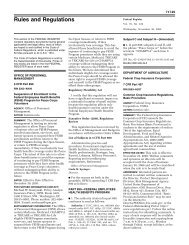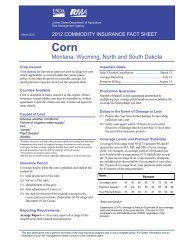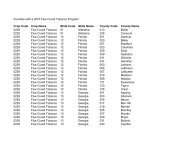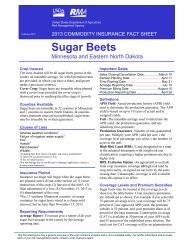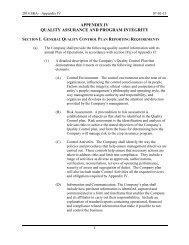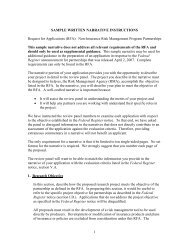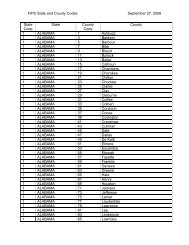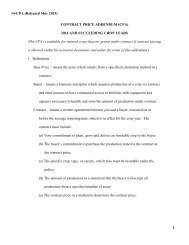Rainfall Index - RMA USDA Risk Management Agency - US ...
Rainfall Index - RMA USDA Risk Management Agency - US ...
Rainfall Index - RMA USDA Risk Management Agency - US ...
You also want an ePaper? Increase the reach of your titles
YUMPU automatically turns print PDFs into web optimized ePapers that Google loves.
United States<br />
Department of<br />
Agriculture<br />
Program<br />
Aid 2005<br />
A <strong>Risk</strong> <strong>Management</strong> <strong>Agency</strong> Fact Sheet<br />
<strong>Rainfall</strong> <strong>Index</strong> Pilot Program<br />
November 2010<br />
The <strong>Risk</strong> <strong>Management</strong> <strong>Agency</strong> is now offering<br />
pilot Basic Provisions for the <strong>Rainfall</strong> <strong>Index</strong>.<br />
These Basic Provisions replace the Group <strong>Risk</strong><br />
Plan Basic Provisions for <strong>Rainfall</strong> <strong>Index</strong><br />
insurance programs such as Pasture, Rangeland,<br />
Forage and Apiculture.<br />
The <strong>Rainfall</strong> <strong>Index</strong> is based on National Oceanic<br />
and Atmospheric Administration (NOAA)<br />
Climate Prediction Center data. The database is<br />
the “Improved United States Precipitation<br />
Quality Control System and Analysis” and<br />
contains data from 1948 to the present. Multiple<br />
data sets, including weather, satellite, and radar<br />
data, are interpolated to 0.25 degrees latitude by<br />
0.25 degrees longitude grids that smooth the data<br />
and address the problem of extreme variability of<br />
individual data sets and basis risk which results<br />
from being far from a precipitation data input<br />
source. Losses are calculated based on the<br />
deviation from normal precipitation for the grid<br />
and index interval(s). This insurance coverage is<br />
for a single peril—lack of rain. Coverage is based<br />
on the experience of the entire grid, and NOT<br />
individual farms or ranches or specific weather<br />
stations in the general area.<br />
The precipitation data used for the <strong>Rainfall</strong> <strong>Index</strong><br />
pilot program is data developed and maintained<br />
by NOAA, Climate Prediction Center, and is<br />
used by many government agencies and private<br />
entities. This data does not reflect<br />
the precipitation amounts measured at a specific<br />
weather station(s) within a given grid. The data is<br />
validated and reflects a smoothed result<br />
of nearby weather, radar, and satellite estimates<br />
to return a total estimate for the grid. The data set<br />
is the "Unified Rain Gauge Dataset" and goes<br />
through a rigorous set of quality control checks<br />
by Climate Prediction Center, including checks<br />
for extreme values, comparisons of observed<br />
amounts among nearby weather data sources,<br />
satellite data, and comparisons to NEXRAD data.<br />
The outcome is a composite value for the<br />
entire grid that cannot be traced to a single<br />
point or data set.<br />
There are two different crop policies, Pasture,<br />
Rangeland, Forage and Apiculture, that use the<br />
<strong>Rainfall</strong> <strong>Index</strong> Basic Provisions. The <strong>Rainfall</strong><br />
<strong>Index</strong> Basic Provisions and the specific crop<br />
provisions, along with other insurance<br />
documents, such as actuarial documents, together<br />
make up a complete insurance program. The<br />
program is available in six regions across the<br />
country to test the <strong>Rainfall</strong> <strong>Index</strong> in various<br />
climates, soils, and weather conditions: the warm<br />
and humid Southeast, the cool and humid<br />
Northeast, the Northern Great Plains, the<br />
Southern Great Plains, the semi-arid Southwest,<br />
and the intermountain region of the Northwest.<br />
This insurance plan is designed as a risk<br />
management tool to insure against a decline in<br />
the <strong>Rainfall</strong> <strong>Index</strong> for a grid. It is possible for<br />
policyholders to have low production or low<br />
precipitation on their insured acreage and not<br />
receive an indemnity under the <strong>Rainfall</strong> <strong>Index</strong><br />
plan of insurance. The only insurable cause of<br />
loss for an <strong>Rainfall</strong> <strong>Index</strong> policy is having a<br />
final grid index less than the trigger grid<br />
index. Because the program is designed for<br />
producers whose production and precipitation<br />
This fact sheet gives only a general overview of the Federal Crop Insurance Program and is not a complete policy. For further information<br />
and an evaluation of your risk management needs, contact a crop insurance agent.
tend to follow the average precipitation<br />
patterns for the grid and not individual crop<br />
production, it is important that you review the<br />
historical indices, additional tools, and<br />
information provided on the <strong>RMA</strong> Web site to<br />
determine if the program is suitable for you.<br />
The Pasture, Rangeland, Forage and Apiculture<br />
<strong>Rainfall</strong> <strong>Index</strong> and Vegetation <strong>Index</strong> pilot programs<br />
are being tested in select counties and States. You can<br />
view a map and a list of the counties and States where<br />
each index is available at: http://www.rma.usda.gov/<br />
policies/pasturerangeforage, for Pasture, Rangeland,<br />
Forage or at: http://www.rma.usda.gov/policies/ri-vi/<br />
apiculture.html for Apiculture.<br />
Contact Us<br />
United States Department of Agriculture<br />
<strong>Risk</strong> <strong>Management</strong> <strong>Agency</strong><br />
1400 Independence Ave., SW, Stop 0801<br />
Washington, D.C. 20250-0801<br />
TEL: (202) 690-2803<br />
FAX: (202) 690-2818<br />
Web site: http://www.rma.usda.gov<br />
Email: rma.cco@rma.usda.gov<br />
Download Copies from the Web<br />
Visit our online publications/fact sheets page at:<br />
http://www.rma.usda.gov/pubs/rme/fctsht.html<br />
The U.S. Department of Agriculture (<strong><strong>US</strong>DA</strong>) prohibits discrimination<br />
in all its programs and activities on the basis of race,<br />
color, national origin, age, disability, and where applicable, sex,<br />
marital status, familial status, parental status, religion, sexual<br />
orientation, genetic information, political beliefs, reprisal, or<br />
because all or a part of an individual's income is derived from<br />
any public assistance program. (Not all prohibited bases apply<br />
to all programs.) Persons with disabilities who require alternative<br />
means for communication of program information (Braille,<br />
large print, audiotape, etc.) should contact <strong><strong>US</strong>DA</strong>'s TARGET<br />
Center at (202) 720-2600 (voice and TDD).<br />
To file a complaint of discrimination write to: <strong><strong>US</strong>DA</strong>, Director,<br />
Office of Civil Rights, 1400 Independence Avenue, S.W., Washington,<br />
D.C. 20250-9410 or call (800) 795-3272 (voice) or (202)<br />
720-6382 (TDD). <strong><strong>US</strong>DA</strong> is an equal opportunity provider and<br />
employer.<br />
<strong>Risk</strong> <strong>Management</strong> <strong>Agency</strong> <strong>Rainfall</strong><br />
<strong>Index</strong>/PA-2005



